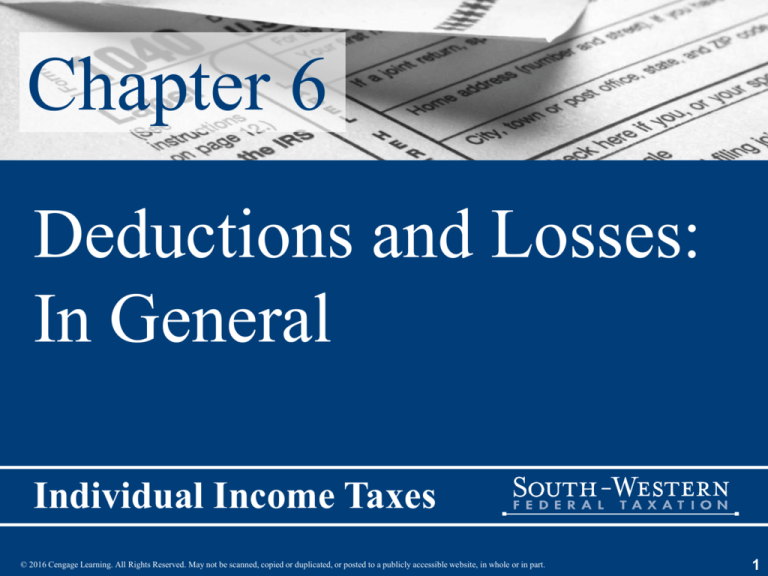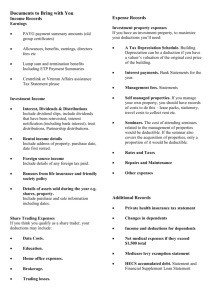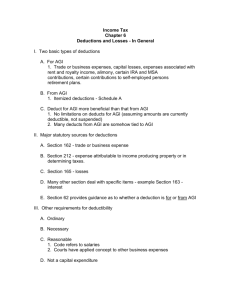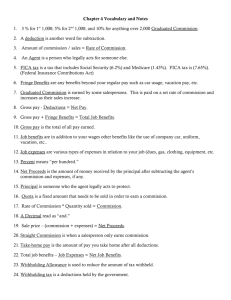
Chapter 6
Deductions and Losses:
In General
Individual Income Taxes
© 2016 Cengage Learning. All Rights Reserved. May not be scanned, copied or duplicated, or posted to a publicly accessible website, in whole or in part.
1
The Big Picture (slide 1 of 2)
• Dr. Cliff Payne determines that his deductible expenses associated with his
dental practice are as follows:
Salaries including FICA (unpaid at year-end of $5,000)
$120,000
Building rent
24,000
Depreciation of dental equipment and office
furnishings and equipment
52,000
Insurance (malpractice and of dental equipment
and office furnishings and equipment)
22,000
Dental supplies
16,000
Office supplies
3,000
Investigation expenses
6,000
Contribution to U.S. Senate campaign fund of Tom Smith
1,000
Contribution to U.S. Senate campaign fund of Virginia White
1,000
Legal expenses associated with patient lawsuit (jury decision for
defendant)
4,000
Fine imposed by city for improper disposal of medical waste
3,000
Dues paid to The Dental Society
10,000
Draw by Dr. Payne for living expenses ($5,000 monthly)
60,000
2
The Big Picture (slide 2 of 2)
• Has Dr. Payne correctly calculated the business
expenses for his dental practice?
– Read the chapter and formulate your response.
3
Deductions
• Exclusive definition of deductions
– Deductions are allowed based on legislative grace
and defined narrowly
– Substantiation requirements
• Taxpayer has burden of proof for substantiating all
expenses deducted on return
• Thus, adequate records of expenses must be maintained
4
Deductions for and
from AGI (slide 1 of 3)
• Deductions for AGI
– Can be claimed even if taxpayer does not itemize
– Important in determining the amount of certain
itemized deductions
• Certain itemized deductions are limited to amounts in
excess of specified percentages of AGI
– e.g., Medial expenses (7.5% or 10% of AGI), misc. itemized
deductions ( 2% of AGI)
5
Deductions for and
from AGI (slide 2 of 3)
• Deductions from AGI:
– In total, must exceed the standard deduction to
provide any tax benefit
– Called “below the line” or itemized deductions
6
Deductions for and
from AGI (slide 3 of 3)
• Comparison of deductions for and from
AGI (2015 tax year)
– Single taxpayer has gross income of $45,000
and a $6,500 deduction
Gross income
Less: for AGI ded.
AGI
Less: from AGI ded.
Less: personal exempt.
Taxable income
For AGI
$45,000
-6,500
$38,500
6,300
4,000
$28,200
From AGI
$45,000
0
$45,000
6,500
4,000
$34,500
7
Deductions for AGI
(slide 1 of 3)
• Partial list includes:
– Trade or business expenses
– Reimbursed employee business expenses
– Deductions from losses on sale or exchange of
property
– Deductions from rental and royalty property
– Alimony
– One-half of self-employment tax paid
8
Deductions for AGI
(slide 2 of 3)
• Partial list includes:
– 100% of health insurance premiums paid by a selfemployed individual
– Contributions to pension, profit sharing, annuity
plans, IRAs, etc.
– Penalty on premature withdrawals from time
savings accounts or deposits
– Moving expenses
9
Deductions for AGI
(slide 3 of 3)
• Partial list includes:
– Interest on student loans
– Qualified tuition and related expenses under § 222
– Up to $250 for teacher supplies for elementary and
secondary school teachers (if extended to 2014 by
Congress)
10
Deductions from AGI
• Itemized deductions include:
–
–
–
–
Medical expenses (in excess of 7.5% or 10% of AGI)
Certain state and local taxes
Contributions to qualified charitable organizations
Personal casualty losses (in excess of 10 % of AGI and a
$100 floor per casualty)
– Certain personal interest expense (e.g., mortgage interest
on a personal residence)
– Miscellaneous itemized deductions (in excess of 2% of
AGI)
11
Deductions from AGI
• Itemized deductions include:
–
–
–
–
Medical expenses (in excess of 7.5% or 10% of AGI)
Certain state and local taxes
Contributions to qualified charitable organizations
Personal casualty losses (in excess of 10 % of AGI and a
$100 floor per casualty)
– Certain personal interest expense (e.g., mortgage interest
on a personal residence)
– Miscellaneous itemized deductions (in excess of 2% of
AGI)
12
Trade or Business Deductions
(slide 1 of 2)
• Section 162(a) permits a deduction for all
ordinary and necessary expenses paid or
incurred in carrying on a trade or business
including:
– Reasonable salaries paid for services
– Expenses for the use of business property
– One-half of self-employment taxes paid
• Such expenses are deducted for AGI
13
Trade or Business Deductions
(slide 1 of 2)
• Section 162(a) permits a deduction for all
ordinary and necessary expenses paid or
incurred in carrying on a trade or business
including:
– Reasonable salaries paid for services
– Expenses for the use of business property
– One-half of self-employment taxes paid
• Such expenses are deducted for AGI
14
Trade or Business Deductions
(slide 2 of 2)
• In order for expenses to be deductible, they
must be:
– Ordinary: normal, usual, or customary for others in
similar business, and not capital in nature
– Necessary: prudent businessperson would incur
same expense
– Reasonable: question of fact
– Incurred in conduct of business
15
Trade or Business Deductions
(slide 2 of 2)
• In order for expenses to be deductible, they
must be:
– Ordinary: normal, usual, or customary for others in
similar business, and not capital in nature
– Necessary: prudent businessperson would incur
same expense
– Reasonable: question of fact
– Incurred in conduct of business
16
Section 212 Expenses (slide 1 of 2)
• Section 212 allows deductions for ordinary and
necessary expenses paid or incurred for the
following:
– The production or collection of income
– The management, conservation, or maintenance of
property held for the production of income
– Expenses paid in connection with the
determination, collection, or refund of any tax
17
Section 212 Expenses (slide 2 of 2)
• § 212 expenses that are deductions for AGI include:
– Expenses related to rent and royalty income
– Expenses paid in connection with the determination,
collection, or refund of taxes related to the income of sole
proprietorships, rents and royalties, or farming operations
• All other § 212 expenses are itemized deductions
(deductions from AGI)
– For example, investment-related expenses (e.g., safe
deposit box rentals) are deductible as itemized deductions
attributable to the production of investment income
18
Business And
Nonbusiness Losses
• Deductible losses of individual taxpayers are
limited to those:
– Incurred in a trade or business,
– Incurred in a transaction entered into for profit
• Individuals may also deduct casualty losses
from fire, storm, shipwreck, and theft
19
Methods of Accounting
• The method of accounting affects when
deductions are taken
– Cash: expenses are deductible only when paid
– Accrual: expenses are deductible when incurred
• Apply the all events test and the economic performance
test
– Exception to the economic performance test for recurring
items
20
Methods of Accounting
• The method of accounting affects when
deductions are taken
– Cash: expenses are deductible only when paid
– Accrual: expenses are deductible when incurred
• Apply the all events test and the economic performance
test
– Exception to the economic performance test for recurring
items
21
Methods of Accounting
• The method of accounting affects when
deductions are taken
– Cash: expenses are deductible only when paid
– Accrual: expenses are deductible when incurred
• Apply the all events test and the economic performance
test
– Exception to the economic performance test for recurring
items
22
Methods of Accounting
• The method of accounting affects when
deductions are taken
– Cash: expenses are deductible only when paid
– Accrual: expenses are deductible when incurred
• Apply the all events test and the economic performance
test
– Exception to the economic performance test for recurring
items
23
Disallowance Possibilities
• The tax law disallows the deduction of certain types
of expenses for a variety of reasons
– e.g., May restrict taxpayer attempts to deduct certain items
that, in reality, are personal expenditures
• Certain disallowance provisions are a codification or
extension of prior court decisions
– e.g., After courts denied deductions for payments in
violation of public policy, tax law was changed to provide
specific authority for the disallowance
24
Expenditures Contrary
To Public Policy
• Deductions are disallowed for certain specific
types of expenditures that are considered
contrary to public policy
– Examples: penalties, fines, illegal bribes or
kickbacks, two-thirds of treble damage payments
for violation of anti-trust law
25
The Big Picture - Example 13
Nondeductible Fines
• Return to the facts of The Big Picture on p. 6-1.
• Dr. Payne had not instituted proper procedures for
disposing of medical waste from his laboratory.
– During the current tax year, he was fined $3,000
by the city.
– Dr. Payne believes the fine should be deducted as
an ordinary business expense.
• However, because the fine was due to a
violation of public policy, the $3,000 is not
deductible.
26
Legal Expenses Incurred In Defense
Of Civil Or Criminal Penalties
• To deduct legal expenses
– Must be directly related to a trade or business, an
income producing activity, or the determination,
collection, or refund of a tax
• e.g., Corporate officer’s legal fees in defending against
price-fixing charges
• e.g., Landlord’s legal fees associated with eviction of
tenant
27
Expenses Relating To
An Illegal Business
• Usual expenses of operating an illegal business
are deductible
– However, deduction for fines, bribes to public
officials, illegal kickbacks, and other illegal
payments are disallowed
• Trafficking in controlled substances: only cost
of goods sold can reduce gross income
28
Expenses Relating To
An Illegal Business
• Usual expenses of operating an illegal business
are deductible
– However, deduction for fines, bribes to public
officials, illegal kickbacks, and other illegal
payments are disallowed
• Trafficking in controlled substances: only cost
of goods sold can reduce gross income
29
Political Contributions And
Lobbying Activities
• Generally, no business deduction is allowed
for payments made for political purposes or for
lobbying
– Exceptions are allowed for lobbying:
• To influence local legislation,
• To monitor legislation, and
• De minimis in-house expenses (limited to $2,000)
– If greater than $2,000, none can be deducted
30
The Big Picture - Example 17
Political Contributions
• Return to the facts of The Big Picture on p. 6-1.
• Dr. Payne made political contributions to the State Senate
campaigns of Tom Smith and Virginia White.
– Dr. Payne made these contributions to encourage these
senators to support a new bill that is beneficial to the state’s
dental profession.
– Therefore, he assumed that these would be deductible
business expenses.
• However, political contributions are not deductible,
so he will receive no tax benefit from them.
31
Excessive Executive Compensation
(slide 1 of 2)
• For publicly held corporations:
– Deduction for compensation of CEO and four
other highest compensated officers is limited to $1
million each
– Does not include:
• Certain performance-based compensation
• Payments to qualified retirement plans
• Payments excludible from gross income
32
Excessive Executive Compensation
(slide 2 of 2)
• An additional limitation applies only to
covered executives of companies receiving
Troubled Asset Relief Program (TARP)
assistance
– The deduction for compensation paid to a covered
executive is limited to $500,000
– Covered employees include the CEO, the CFO,
and the three other most highly compensated
officers
33
Investigation Of A Business
(slide 1 of 3)
• Investigation expenses - incurred to determine the
feasibility of entering a new business or expanding an
existing business
– Include costs such as travel, engineering, architectural
surveys, marketing reports, various legal and accounting
services
• Tax treatment of these expenses depends on:
–
–
–
–
The current business, if any, of the taxpayer
The nature of the business being investigated
The extent to which the investigation has proceeded
Whether or not the acquisition actually takes place
34
Investigation Of A Business
(slide 2 of 3)
• If the taxpayer is in a business the same as or
similar to that being investigated
– Investigation expenses are deductible in the year
paid or incurred
• The tax result is the same whether or not the taxpayer
acquires the business being investigated
35
Investigation Of A Business
(slide 3 of 3)
• When the taxpayer is not in a business the same as or
similar to that being investigated
– Tax result depends on whether new business is acquired
• If not acquired
– All investigation expenses generally are nondeductible
• If acquired
– Investigation expenses must be capitalized
– May elect to deduct the first $5,000 of expenses currently
– Any excess expenses can be amortized over a period of not less than
180 months (15 years)
– In arriving at the $5,000 immediate deduction allowed, a dollar-fordollar reduction must be made for those expenses in excess of
$50,000
36
The Big Picture - Example 19
Investigation Of A Business (slide 1 of 2)
• Return to the facts of The Big Picture on p. 6-1.
• Dr. Payne believes that his administrative and
business skills can be used to turn around dental
practices whose revenues have been declining.
– He investigates Teeth Restoration, LLC, a local dental
practice that is for sale.
– Expenses paid to consultants and accountants as
part of this investigation totaled $6,000.
– He determined that Teeth Restoration would not be
a good investment, so he did not buy it.
37
The Big Picture - Example 19
Investigation Of A Business (slide 2 of 2)
• Return to the facts of The Big Picture on p. 6-1.
• The $6,000 spent to investigate this business is
deductible as a business expense because Dr. Payne is
already in the dental business.
– Investigating new business opportunities in one’s current
trade or business is an ordinary and necessary business
expense.
38
Hobby Losses (slide 1 of 8)
• Hobby defined
– Activity not entered into for profit
• Personal pleasure associated with activity
• Examples: raising horses, fishing boat charter
• If an activity is not engaged in for profit, the
hobby loss rules apply
– Hobby expenses are deductible only to the extent
of hobby income
39
Hobby Losses (slide 2 of 8)
• Profit activity
– If activity is entered into for profit, taxpayer can
deduct expenses for AGI even in excess of income
from the activity
• At-risk and passive loss rules may apply
• Often it is difficult to determine if an activity
is profit motivated or a hobby
• Regulations provide nine factors to consider in making
this determination
40
Hobby Losses (slide 3 of 8)
• Presumptive rule of § 183
– If activity shows profit 3 out of 5 years (2 out of 7
years for horses), the activity is presumed to be a
trade or business rather than a personal hobby
– Rebuttable presumption, shifts burden of proof to IRS
– Otherwise, taxpayer has burden to prove profit
motive
41
Hobby Losses (slide 4 of 8)
Year
Income (loss)
2009
2010
2011
2012
2013
2014
2015
$500
(1,500)
700
(1,000)
900
(500)
1,200
Hobby?
Yes
Yes
Yes
Yes
No, profit 3 of 5 years
Yes, profit only 2 of 5 years
No, profit 3 of 5 years
42
Hobby Losses (slide 5 of 8)
• If an activity is deemed to be a hobby
– Can only deduct expenses to extent of income
from activity (i.e., cannot deduct hobby losses)
43
Hobby Losses (slide 6 of 8)
• If an activity is a hobby:
– Expenses are deductible from AGI
• Treated as miscellaneous itemized deductions subject to
the 2% of AGI limitation
• Exception: expenses that are deductible without regard
to profit motive are deductible in full, such as
– Home mortgage interest
– Property taxes
44
Hobby Losses (slide 7 of 8)
• Order in which hobby expenses are deductible:
– First: Those otherwise deductible: e.g., home
mortgage interest and property taxes
– Then: Expenses that do not affect adjusted basis:
e.g., maintenance, utilities
– Then: Expenses that affect adjusted basis: e.g.,
depreciation (or cost recovery)
45
Hobby Losses (slide 8 of 8)
• Example of hobby expenses: Taxpayer sells
horses raised as a hobby for $15,500
Amount
Order
Amount
Income
$15,500
Interest
6,000
1
$ 6,000
Taxes
3,000
1
3,000
Vet Bills
2,000
2
2,000
Feed
4,000
2
4,000
Depreciation
1,000
3
Ltd. to 500
Total
15,500
46
Rental Vacation Homes
(slide 1 of 9)
• May have both personal and rental use of a
vacation home
• Deduction of rental expenses may be limited to
rental income if primarily used for personal
purposes
• Determination of vacation home treatment is
dependent on personal use vs. rental use
47
Rental Vacation Homes
(slide 2 of 9)
• Rental days
– Less than 15 days: No gross income recognized
from rentals and no deductible rental expenses
• Mortgage interest and property taxes treated as if on
personal residence (generally deductible in full)
– More than 14 days: Treatment depends on amount
of personal use
48
Rental Vacation Homes
(slide 3 of 9)
• Primarily rental use
– If rented for 15 days or more and personal use
days NOT more than the greater of 14 days or 10
percent of fair rental days
– Can deduct all expenses allocated to rental use
even if loss results
• Rental loss subject to at-risk and passive loss rules
49
Rental Vacation Homes
(slide 4 of 9)
• Personal/rental use
– If rented for 15 days or more and personal use
days exceed the greater of 14 days or 10% of fair
rental days
– Treated similar to hobby
• Rental expenses deducted in three step process
• No rental loss allowed
• Carryforward of disallowed rental expenses
50
Rental Vacation Homes
(slide 5 of 9)
• Example of personal use
Rental days: 200 (10% = 20)
Personal use
7 days
18 days
25 days
Not Significant
X
X
Significant
X
51
Rental Vacation Homes
(slide 6 of 9)
• Example of personal use
Rental days: 100 (10% = 10)
Personal Use
7 days
14 days
18 days
Not Significant
X
X
Significant
X
52
Rental Vacation Homes
(slide 7 of 9)
• Allocation of expenses between personal and
rental
– Mortgage interest and real estate taxes
• IRS requires allocation based on total days used
• Courts have allowed allocation based on days in year
– Other expenses are allocated based on total days
used
53
Rental Vacation Homes
(slide 8 of 9)
• Tax treatment of income and expenses of a
primarily rental vacation home
– Rental income included in gross income
– Rental expenses deductible for AGI
– Rental income and expenses reported on Sch. E
54
Rental Vacation Homes
(slide 9 of 9)
• Treatment of allocated personal portion of
vacation home expenses
– Primarily rental use: taxes deductible from AGI,
mortgage interest nondeductible (personal interest)
– Personal/rental use: mortgage interest and taxes
deductible from AGI
– Personal portion of other expenses (e.g., insurance,
maintenance) nondeductible
55
Expenditures Incurred for Taxpayer’s
Benefit or Obligation
• No deduction is allowed for payment of
another taxpayer’s expenses
– Must be incurred for taxpayer’s benefit or arise
from taxpayer’s obligation
– Exception: Payment of medical expenses for a
dependent
56
Personal Expenditures
• Unless otherwise provided in the Code,
personal expenses are not deductible
57
Personal Expenditures
• Unless otherwise provided in the Code,
personal expenses are not deductible
58
Capital Expenditures
• Amounts are capitalized
• Asset may be subject to depreciation (or cost
recovery), amortization, or depletion
59
Transactions Between Related Parties
(slide 1 of 2)
• Section 267 disallows losses from direct or
indirect sales or exchanges of property
between related parties
– Family and entity relationships apply
– Constructive ownership rules apply
– Loss disallowed may reduce gain on subsequent
disposition to unrelated third party
60
Transactions Between Related Parties
(slide 1 of 2)
• Section 267 disallows losses from direct or
indirect sales or exchanges of property
between related parties
– Family and entity relationships apply
– Constructive ownership rules apply
– Loss disallowed may reduce gain on subsequent
disposition to unrelated third party
61
Transactions Between Related Parties
(slide 1 of 2)
• Section 267 disallows losses from direct or
indirect sales or exchanges of property
between related parties
– Family and entity relationships apply
– Constructive ownership rules apply
– Loss disallowed may reduce gain on subsequent
disposition to unrelated third party
62
Transactions Between Related Parties
(slide 2 of 2)
• Section 267 also requires the matching
principle be applied for unpaid expenses and
interest when different accounting methods
used
– Example: An accrual basis, closely held
corporation, cannot deduct accrued, but unpaid,
salary to cash basis related party
employee/shareholder until it is actually paid
63
Expenses and Interest Relating to
Tax-Exempt Income
• Expenses relating to production of tax-exempt
income are nondeductible
– Example: interest expense on loan where funds
used to acquire municipal bonds
64
Refocus On The Big Picture (slide 1 of 2)
• Of the expenses incurred by Dr. Payne, several comments
need to be made.
– Being personal in nature, none of the $5,000 monthly draw
is deductible and the amount involved is not subject to the
reasonableness test (see Example 6).
• Dr. Payne is a sole proprietor and not in an employment
relationship.
– The fine paid for violating waste control rules comes under
the public policy limitations (see Example 13) and is
specifically made nondeductible by Code § 162(f).
– Along the same line are the political contributions
(Example 17) made nondeductible by § 162(e).
65
Refocus On The Big Picture (slide 2 of 2)
• However, Dr. Payne’s investigation of the practice of another
dental firm (Example 19) appears reasonable and the expense
incurred deductible.
• The dues paid to The Dental Society are not
100% deductible because 70% of the Society’s efforts relate to
lobbying activities.
• Although not specifically discussed in the text, Dr. Payne’s
legal fees incurred in connection with a lawsuit filed by a
patient appear related to his practice (Example 15).
– As such, they are ordinary and necessary to his trade or business.
66
If you have any comments or suggestions concerning this
PowerPoint Presentation for South-Western Federal
Taxation, please contact:
Dr. Donald R. Trippeer, CPA
trippedr@oneonta.edu
SUNY Oneonta
© 2016 Cengage Learning. All Rights Reserved. May not be scanned, copied or duplicated, or posted to a publicly accessible website, in whole or in part.
67






